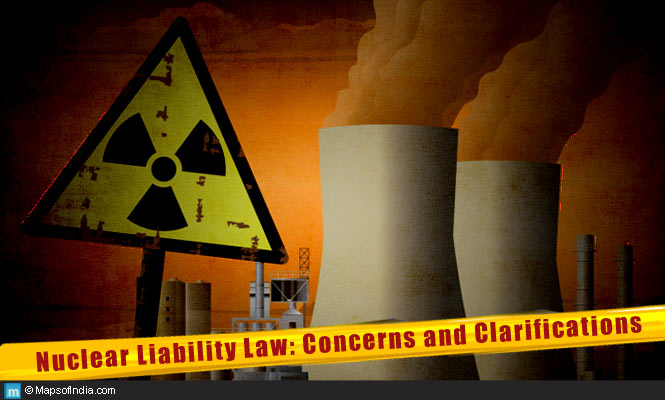News Highlight
India’s nuclear liability law, Maharashtra’s Jaitapur, is currently the world’s biggest nuclear power generation site under consideration.
Key Takeaway
- Problems with India’s nuclear liability law continue to impede a more than a decade-old plan to build six nuclear power reactors in Maharashtra’s Jaitapur.
- It is currently under consideration as the world’s largest nuclear power-producing site.
- An executive from Electricite de France (EDF), the French energy utility that filed its techno-commercial offer for the 9,900 MW project two years ago.
Civil Liability for Nuclear Damage Act, 2010
- Key Features
- It establishes culpability for nuclear damage and outlines processes for victim compensation.
- The Bill imposes no-fault liability on operators and grants them recourse against specified individuals.
- It limits the operator’s liability to Rs 500 crore.
- The central government will be liable for damages over this sum, up to 300 million SDR.
- All operators must obtain insurance or give financial security to cover their liabilities.
- The government will bear the entire liability for government-owned facilities up to 300 million SDR.
- The Bill establishes who can file a compensation claim and who will analyse and grant compensation for nuclear damage.
- Objectives
- To provide an overview of the organisations in charge of calculating and disbursing compensation for nuclear injury.
- In addition, who is entitled to file a compensation claim.
- Before completing their agreements, all operators must have insurance or some other form of financial security.
- To provide legal accountability for nuclear harm and compensation mechanisms for victims.
- To develop a no-fault liability system.
Criticisms about the CLNDA, 2010
- Clause 6
- This clause of the Civil Nuclear Liability Act of 2010 establishes the financial responsibility of operators in the event of a nuclear disaster.
- The significant issues in this clause are:
- The maximum operator liability limit is fixed at INR 1500 crores.
- In the event of a significant calamity, such as the Bhopal Gas Tragedy, it may be insufficient to pay the victims.
- The maximum cap on operators’ civil liabilities is minimal compared to other countries.
- This reduces the load on suppliers while increasing the burden on taxpayers.
- The significant issues in this clause are:
- Clause 17
- This section establishes the legal obligations of liable groups in the event of a nuclear accident.
- The clause appears flawed because it only allows the operator to sue manufacturers and suppliers.
- The victims have no legal recourse against the operator or the supplier.
- As a result, this section diminishes the standing of victims in legal procedures.
- Clause 18
- Compensation claims must be lodged within ten years of the occurrence of the disaster, according to clause 18 of the Civil Liability for Nuclear Damage Act of 2010.
- This time limit is insufficient because the effects of nuclear harm are often long-term.
- This clause of the Civil Nuclear Liability Act of 2010 establishes the financial responsibility of operators in the event of a nuclear disaster.
CLNDA – Environmental Loss
- The Civil Nuclear Liability Act of 2010 ignores environmental damage caused by a nuclear disaster.
- The act addresses victim compensation, not holding operators liable for environmental damage.
- Nuclear energy is a renewable energy source that must be exploited appropriately to avoid the depletion of natural resources.
- The challenge, however, is the devastation caused by nuclear mishaps on people and the environment.
- As a result, the Civil Liability for Nuclear Damage Act of 2010 is critical for protecting people’s lives and property.
- The act requires the government and the operator to accept responsibility for the incident and compensate victims appropriately.
CLND Act affect average Indians
- The CNLD statute limited all liabilities to 300 million Special Drawing Rights or Rs 2610 crore.
- In the event of nuclear damage, the government will now be liable for an additional Rs 1110 crores.
- As a result, the government will wind up spending money from Indian taxpayers, which should be the providers’ responsibility.
- The restricted sum of Rs 2610 will not suffice in case of a nuclear mishap, as demonstrated by the Fukushima nuclear tragedy.
- As a result, potential victims will suffer.
- Section 17 of the CNLD acts states that an operator’s right to redress is not mandatory but an enabling clause.
- This will make it illegal for operators to sue providers.
- As a result, sufferers will be more prone to potential mishaps.
- The suppliers will pay a minimal premium to the ‘Nuclear Insurance Pool’.
- It would be added to the total cost of constructing a nuclear plant, which Indian customers will bear.
- Section 46 bars Indian victims from seeking redress in a foreign court.
- It also makes it illegal to seek compensation under other laws.
Pic Courtesy: India Map
Content Source: The Hindu



